2009 Hyundai Getz engine oil
[x] Cancel search: engine oilPage 10 of 191

YOUR VEHICLE AT A GLANCE
F10
G255A01TB-DAT INDICATOR SYMBOLS ON THE INSTRUMENT PANEL * A detailed explanation of these items will be found on page 1-37
SRS (Airbag) Service Reminder Indicator ABS Service Reminder Indicator Turn Signal Indicator Lights High Beam Indicator Light Oil Pressure Warning Light Hand Brake/Brake Fluid Level Warning Light Charging System Warning LightTail Gate Open Warning Light
Door Ajar Warning Light and Chime
Low Fuel Level Warning Light Malfunction Indicator Light Seat Belt Reminder Light
O/D OFF Indicator (Automatic transaxle only)
Immobiliser Indicator Light
Electronic Stability Program Indicator Lights (If Installed)
Engine Coolant Temperature Indicator
Page 46 of 191
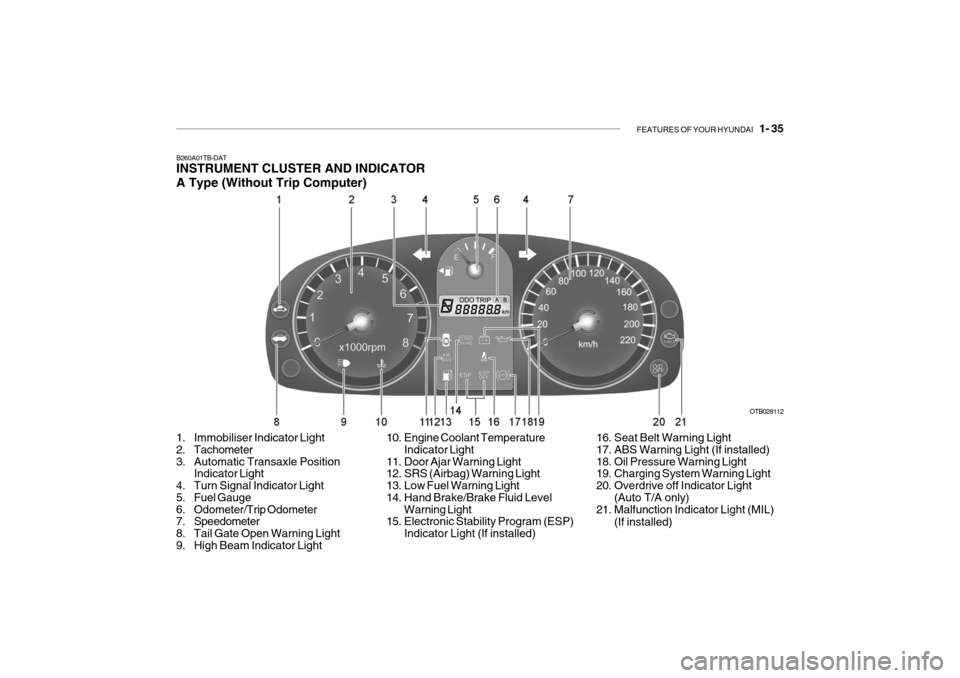
FEATURES OF YOUR HYUNDAI 1- 35
B260A01TB-DAT INSTRUMENT CLUSTER AND INDICATOR A Type (Without Trip Computer)
1. Immobiliser Indicator Light
2. Tachometer
3. Automatic Transaxle Position Indicator Light
4. Turn Signal Indicator Light
5. Fuel Gauge
6. Odometer/Trip Odometer
7. Speedometer
8. Tail Gate Open Warning Light
9. High Beam Indicator Light OTB028112
10. Engine Coolant Temperature Indicator Light
11. Door Ajar Warning Light
12. SRS (Airbag) Warning Light
13. Low Fuel Warning Light
14. Hand Brake/Brake Fluid Level Warning Light
15. Electronic Stability Program (ESP)
Indicator Light (If installed) 16. Seat Belt Warning Light
17. ABS Warning Light (If installed)
18. Oil Pressure Warning Light
19. Charging System Warning Light
20. Overdrive off Indicator Light
(Auto T/A only)
21. Malfunction Indicator Light (MIL)
(If installed)
Page 47 of 191
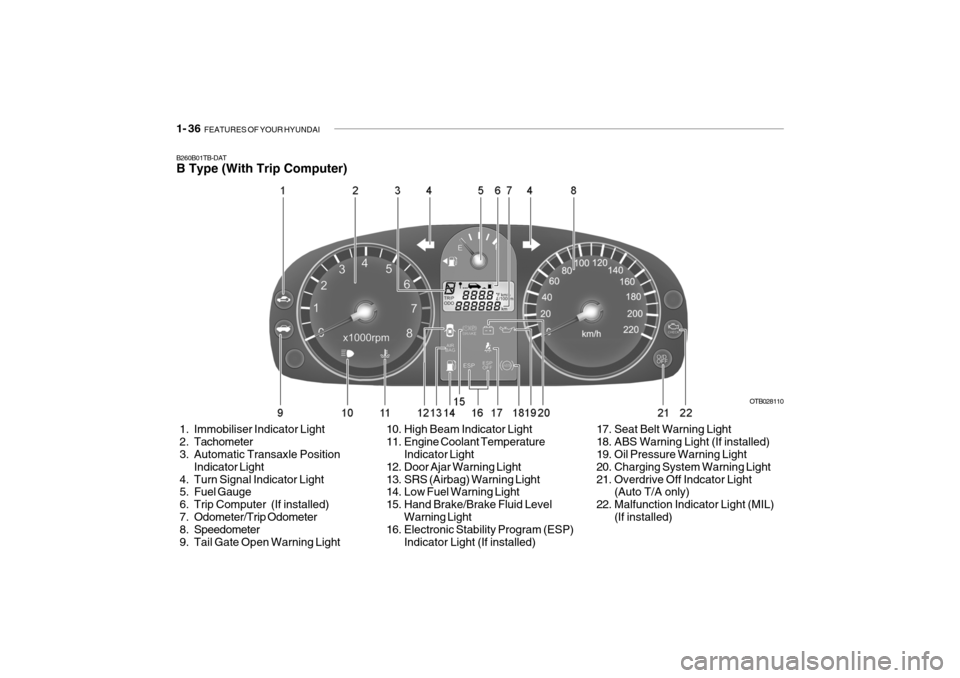
1- 36 FEATURES OF YOUR HYUNDAI
B260B01TB-DAT B Type (With Trip Computer)
1. Immobiliser Indicator Light
2. Tachometer
3. Automatic Transaxle Position
Indicator Light
4. Turn Signal Indicator Light
5. Fuel Gauge
6. Trip Computer (If installed)
7. Odometer/Trip Odometer
8. Speedometer
9. Tail Gate Open Warning Light OTB028110
10. High Beam Indicator Light
11. Engine Coolant Temperature Indicator Light
12. Door Ajar Warning Light
13. SRS (Airbag) Warning Light
14. Low Fuel Warning Light
15. Hand Brake/Brake Fluid Level
Warning Light
16. Electronic Stability Program (ESP)
Indicator Light (If installed) 17. Seat Belt Warning Light
18. ABS Warning Light (If installed)
19. Oil Pressure Warning Light
20. Charging System Warning Light
21. Overdrive Off Indcator Light
(Auto T/A only)
22. Malfunction Indicator Light (MIL)
(If installed)
Page 49 of 191
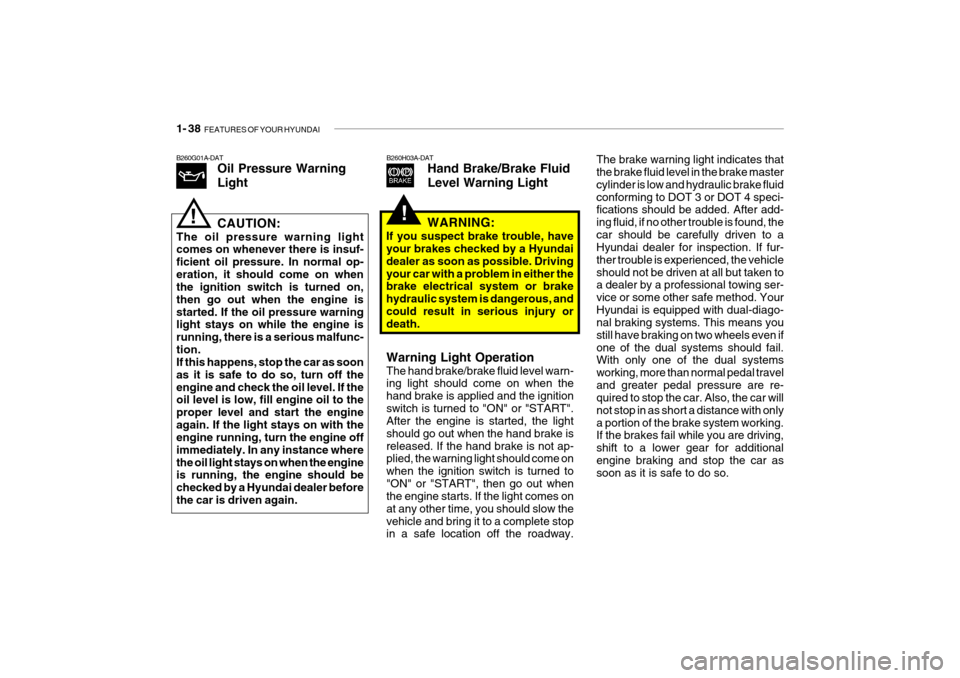
1- 38 FEATURES OF YOUR HYUNDAI
The brake warning light indicates that the brake fluid level in the brake master cylinder is low and hydraulic brake fluidconforming to DOT 3 or DOT 4 speci- fications should be added. After add- ing fluid, if no other trouble is found, thecar should be carefully driven to a Hyundai dealer for inspection. If fur- ther trouble is experienced, the vehicleshould not be driven at all but taken to a dealer by a professional towing ser- vice or some other safe method. YourHyundai is equipped with dual-diago- nal braking systems. This means you still have braking on two wheels even ifone of the dual systems should fail. With only one of the dual systems working, more than normal pedal traveland greater pedal pressure are re- quired to stop the car. Also, the car will not stop in as short a distance with onlya portion of the brake system working. If the brakes fail while you are driving, shift to a lower gear for additionalengine braking and stop the car as soon as it is safe to do so.
!
B260H03A-DAT
Hand Brake/Brake Fluid Level Warning Light
Warning Light Operation The hand brake/brake fluid level warn- ing light should come on when the hand brake is applied and the ignitionswitch is turned to "ON" or "START". After the engine is started, the light should go out when the hand brake isreleased. If the hand brake is not ap- plied, the warning light should come on when the ignition switch is turned to"ON" or "START", then go out when the engine starts. If the light comes on at any other time, you should slow thevehicle and bring it to a complete stop in a safe location off the roadway. WARNING:
If you suspect brake trouble, haveyour brakes checked by a Hyundai dealer as soon as possible. Drivingyour car with a problem in either the brake electrical system or brake hydraulic system is dangerous, andcould result in serious injury or death.
B260G01A-DAT
Oil Pressure Warning Light CAUTION:
The oil pressure warning light comes on whenever there is insuf- ficient oil pressure. In normal op-eration, it should come on when the ignition switch is turned on, then go out when the engine isstarted. If the oil pressure warning light stays on while the engine is running, there is a serious malfunc-tion. If this happens, stop the car as soon as it is safe to do so, turn off theengine and check the oil level. If the oil level is low, fill engine oil to the proper level and start the engineagain. If the light stays on with the engine running, turn the engine off immediately. In any instance wherethe oil light stays on when the engine is running, the engine should be checked by a Hyundai dealer beforethe car is driven again.
!
Page 97 of 191
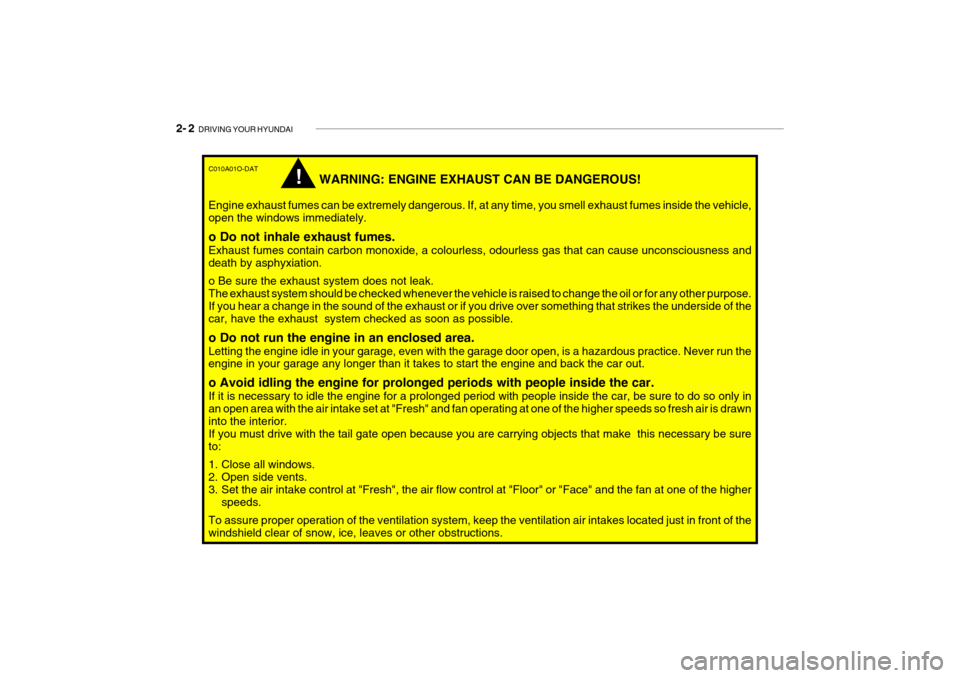
2- 2 DRIVING YOUR HYUNDAI
C010A01O-DAT
WARNING: ENGINE EXHAUST CAN BE DANGEROUS!
Engine exhaust fumes can be extremely dangerous. If, at any time, you smell exhaust fumes inside the vehicle, open the windows immediately. o Do not inhale exhaust fumes. Exhaust fumes contain carbon monoxide, a colourless, odourless gas that can cause unconsciousness and death by asphyxiation. o Be sure the exhaust system does not leak. The exhaust system should be checked whenever the vehicle is raised to change the oil or for any other purpose.If you hear a change in the sound of the exhaust or if you drive over something that strikes the underside of the car, have the exhaust system checked as soon as possible. o Do not run the engine in an enclosed area. Letting the engine idle in your garage, even with the garage door open, is a hazardous practice. Never run the engine in your garage any longer than it takes to start the engine and back the car out. o Avoid idling the engine for prolonged periods with people inside the car. If it is necessary to idle the engine for a prolonged period with people inside the car, be sure to do so only in an open area with the air intake set at "Fresh" and fan operating at one of the higher speeds so fresh air is drawn into the interior. If you must drive with the tail gate open because you are carrying objects that make this necessary be sureto:
1. Close all windows.
2. Open side vents.
3. Set the air intake control at "Fresh", the air flow control at "Floor" or "Face" and the fan at one of the higher speeds.
To assure proper operation of the ventilation system, keep the ventilation air intakes located just in front of the windshield clear of snow, ice, leaves or other obstructions.
!
Page 98 of 191

DRIVING YOUR HYUNDAI 2- 3
!
C020A03S-DAT BEFORE STARTING THE EN- GINE Before you start the engine, you should always:
1. Look around the vehicle to be sure
there are no flat tyres, puddles of oil or water or other indications of pos- sible trouble.
2. After entering the car, check to be sure the parking brake is engaged.
3. Check that all windows, and lights are clean.
4. Check that the interior and exterior
mirrors are clean and in position.
5. Check your seat, seatback and headrest to be sure they are in theirproper positions.
6. Lock all the doors.
7. Fasten your seat belt and be sure
that all other occupants have fas- tened theirs.
8. Turn off all lights and accessories
that are not needed.
9. When you turn the ignition switch to "ON' check that all appropriatewarning lights are operating andthat you have sufficient fuel.
10.Check the operation of warning lights
and all bulbs when key is in the "ON"position. WARNING:
Always wear appropriate shoes whenoperating your vehicle. Unsuitable shoes (high heels, ski boots, etc.) may interfere with yourability to use the brake and accelera- tor pedal, and the clutch (if installed). C030A01A-GAT COMBINATION IGNITION SWITCHTo Start the Engine
o If your Hyundai is equipped with a
manual transaxle, place the shift lever in neutral and depress theclutch pedal fully.
o If your Hyundai has an automatic
transaxle, place the shift lever in "P"(park).
o To start the engine, insert the igni-
tion key and turn it to the "START"position. Release it as soon as the engine starts. Do not hold the key in the "START" position for more than15 seconds.
NOTE: For safety, the engine will not start if the shift lever is not in "P" or "N"Position (Automatic transaxle).
!WARNING:
When you intend to park or stop the vehicle with the engine on, be care- ful not to depress the accelerator pedal for a long period of time. It mayoverheat the engine or exhaust sys- tem and cause fire.
Page 112 of 191

DRIVING YOUR HYUNDAI 2- 17
C160K01A-DAT Carry Emergency Equipment Depending on the severity of the weather where you drive your car, youshould carry appropriate emergency equipment. Some of the items you may want to carry include tyre chains,tow straps or chains, flashlight, emer- gency flares, sand, a shovel, jumper cables, a window scraper, gloves,ground cloth, overalls, a blanket, etc.
C160J01A-AAT Don't Let Ice and Snow Accumu- late Underneath Under some conditions, snow and ice can build up under the fenders and interfere with the steering. When driv-ing in severe winter conditions where this may happen, you should periodi- cally check underneath the car to besure the movement of the front wheels and the steering components are not obstructed.
C170A01A-DAT HIGH SPEED MOTORING Pre-Trip Inspections
1. Tyres: Adjust the tyre inflation pressures to specification. Low tyre inflation pres-sures will result in overheating and possible failure of the tyres. Avoid using worn or damaged tyres whichmay result in reduced traction or tyre failure. NOTE: Never exceed the maximum tyre inflation pressure shown on the tyres.
2. Fuel, engine coolant and engine oil: High speed travel consumes 1.5 times more fuel than urban motoring. Do notforget to check both engine coolant and engine oil.
3. Drive belt: A loose or damaged drive belt may result in overheating of the engine.
C160H01A-DAT Use Approved Anti-Freeze in WindowWasher System To keep the water in the window washer system from freezing, add an approved anti-freeze solution in accordance withinstructions on the container. Window washer anti-freeze is available from Hyundai dealers and most auto partsoutlets. Do not use engine coolant or other types of anti-freeze as these may damage the paint finish.
C160I01L-DAT Don't Let Your Hand Brake Freeze Under some conditions your hand brake can freeze in the engaged posi-tion. This is most likely to happen when there is an accumulation of snow or ice around or near the rear brakes or if thebrakes are wet. If there is a risk the hand brake may freeze, apply it only temporarily while you put the gearselector lever in "P" and block the rear wheels so the car cannot roll. Then release the hand brake.
Page 118 of 191
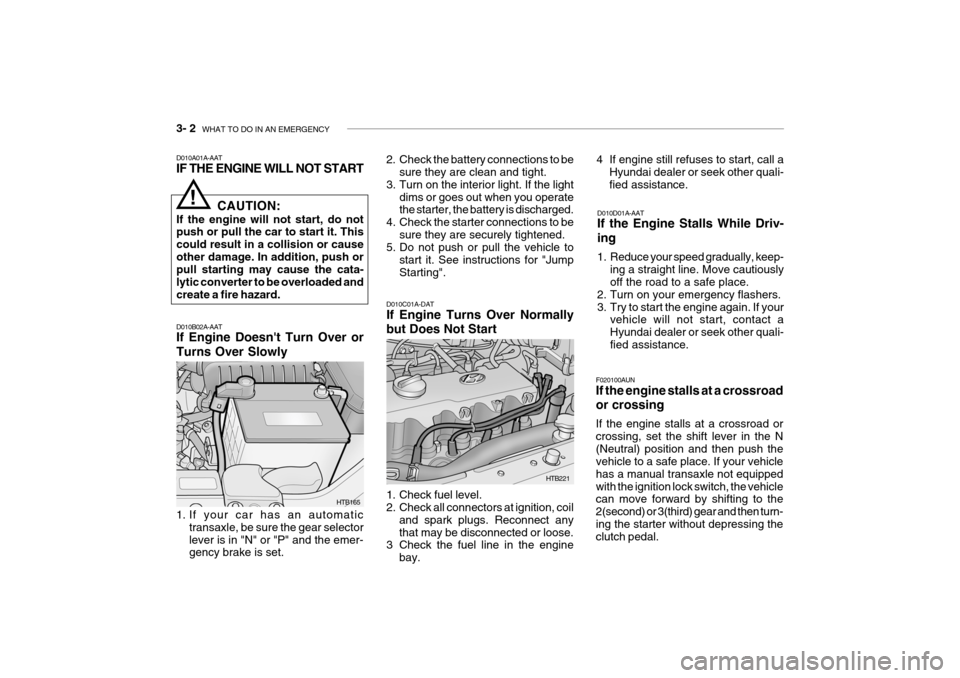
3- 2 WHAT TO DO IN AN EMERGENCY
HTB165
D010B02A-AAT If Engine Doesn't Turn Over or Turns Over Slowly 2. Check the battery connections to be
sure they are clean and tight.
3. Turn on the interior light. If the light dims or goes out when you operate the starter, the battery is discharged.
4. Check the starter connections to be sure they are securely tightened.
5. Do not push or pull the vehicle to
start it. See instructions for "Jump Starting".
D010C01A-DAT If Engine Turns Over Normally but Does Not Start 4 If engine still refuses to start, call a
Hyundai dealer or seek other quali- fied assistance.
D010D01A-AAT If the Engine Stalls While Driv- ing
1. Reduce your speed gradually, keep- ing a straight line. Move cautiously off the road to a safe place.
2. Turn on your emergency flashers.
3. Try to start the engine again. If your vehicle will not start, contact aHyundai dealer or seek other quali-fied assistance.
D010A01A-AAT IF THE ENGINE WILL NOT START
!
HTB221
CAUTION:
If the engine will not start, do not push or pull the car to start it. This could result in a collision or causeother damage. In addition, push or pull starting may cause the cata- lytic converter to be overloaded andcreate a fire hazard.
F020100AUN If the engine stalls at a crossroad or crossing If the engine stalls at a crossroad or crossing, set the shift lever in the N(Neutral) position and then push the vehicle to a safe place. If your vehicle has a manual transaxle not equippedwith the ignition lock switch, the vehicle can move forward by shifting to the 2(second) or 3(third) gear and then turn-ing the starter without depressing the clutch pedal.
1. If your car has an automatic
transaxle, be sure the gear selector lever is in "N" or "P" and the emer- gency brake is set. 1. Check fuel level.
2. Check all connectors at ignition, coil
and spark plugs. Reconnect any that may be disconnected or loose.
3 Check the fuel line in the engine
bay.